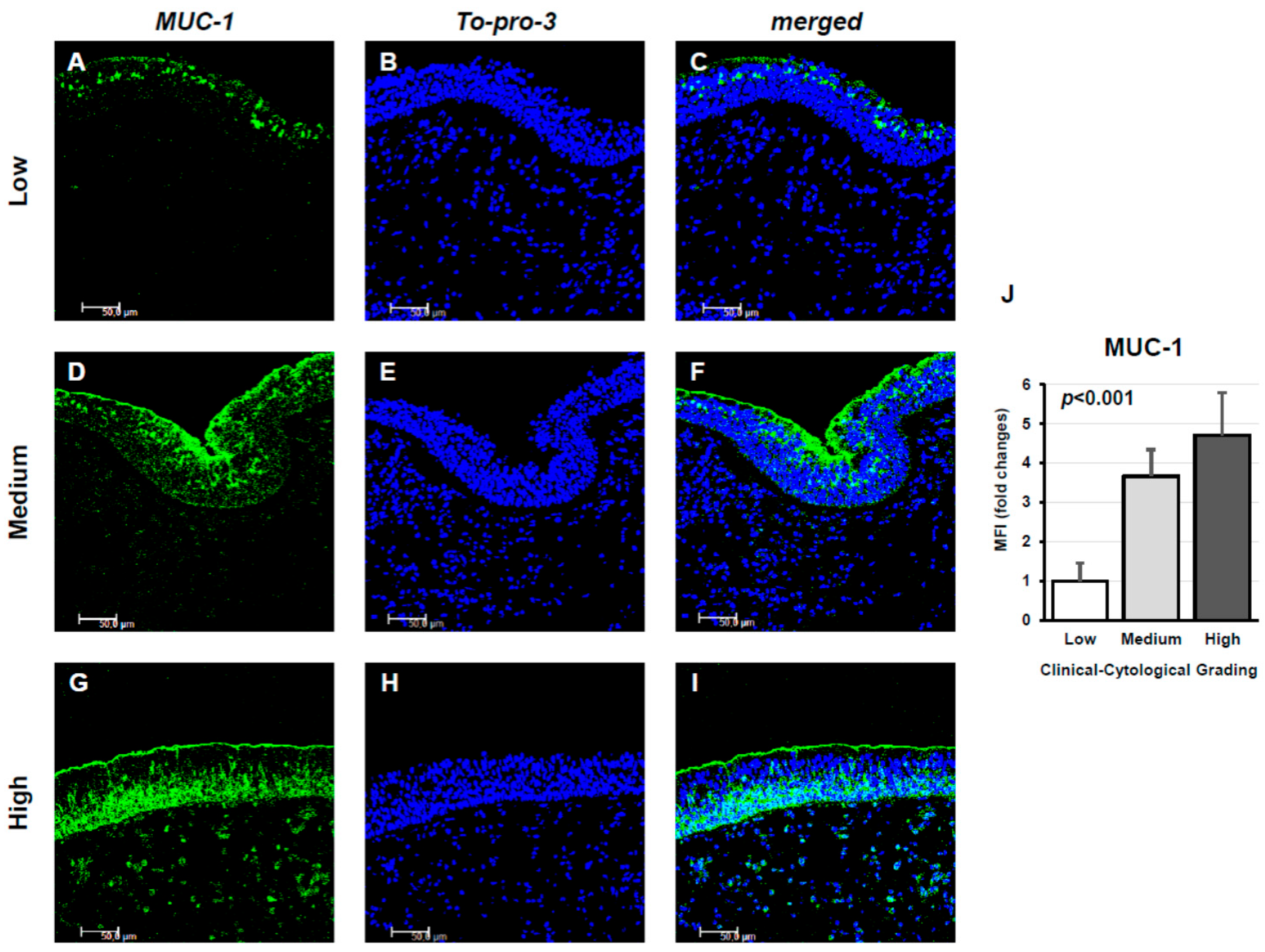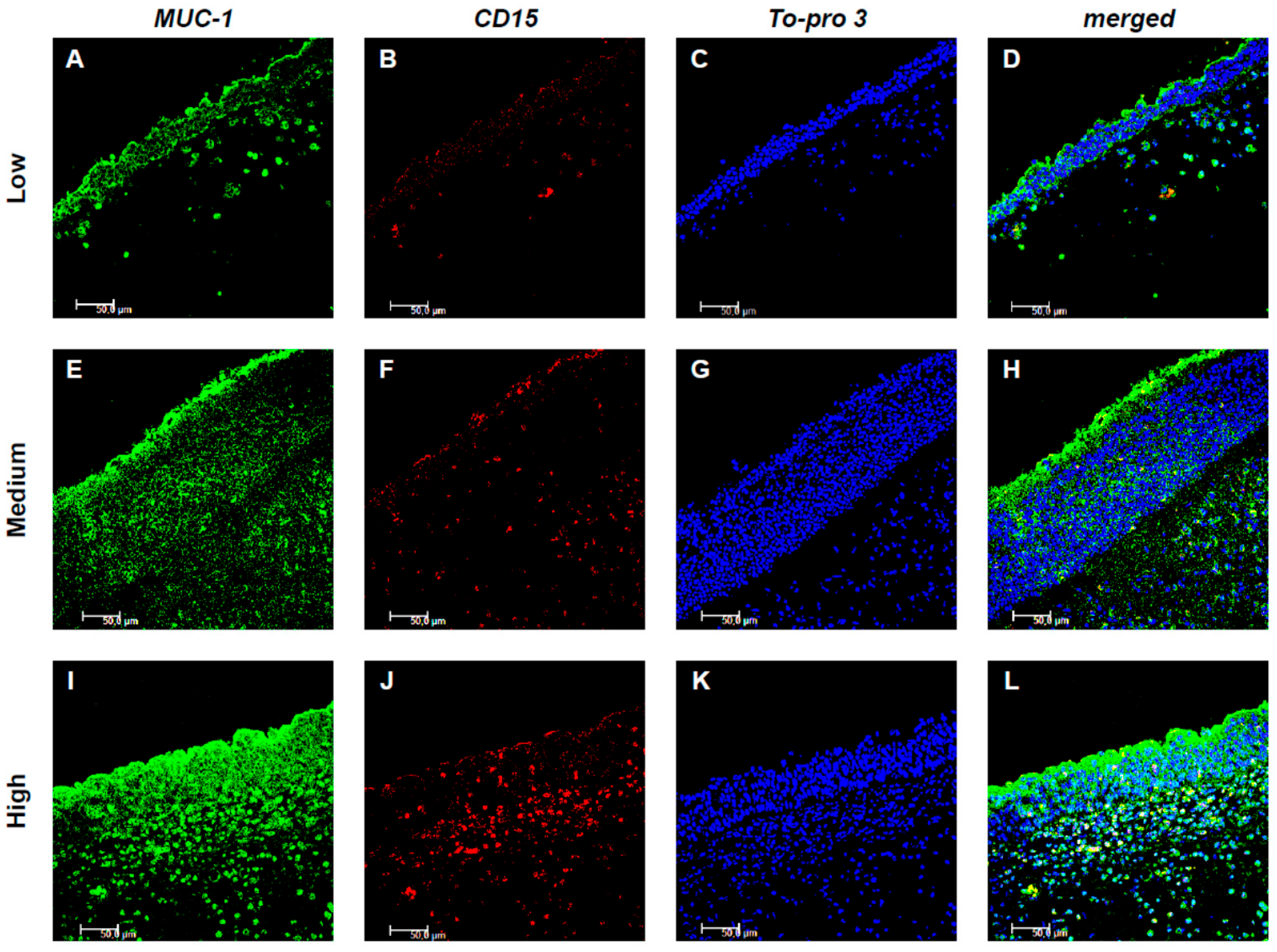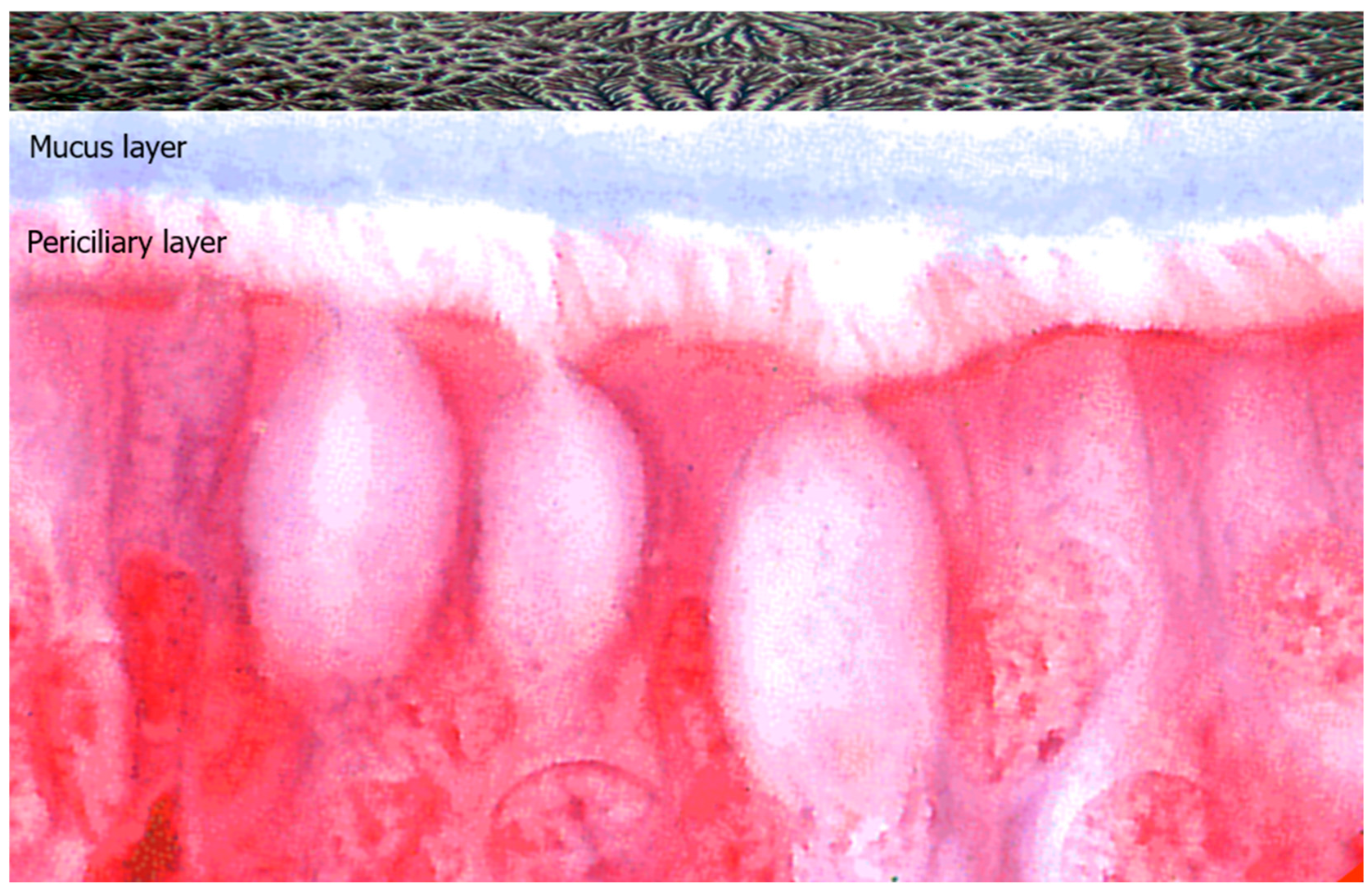The Role of MUC1 in Chronic Rhinosinusitis with Nasal Polyps (CRSwNP): The Correlation with Disease Severity
Abstract
1. Introduction
2. Materials and Methods
2.1. Medical History
2.2. Nasal Endoscopy
2.3. Nasal Cytology and Clinical-Cytological Grading
2.4. Indirect Immunofluorescence and Confocal Laser Scanning Microscopy
3. Results
4. Discussion
5. Conclusions
Author Contributions
Funding
Institutional Review Board Statement
Informed Consent Statement
Data Availability Statement
Conflicts of Interest
References
- Radicioni, G.; Ceppe, A.; Ford, A.A.; Alexis, N.E.; Barr, R.G.; Bleecker, E.R.; Christenson, S.A.; Cooper, C.B.; Han, M.K.; Hansel, N.N.; et al. Airway mucin MUC5AC and MUC5B concentrations and the initiation and progression of chronic obstructive pulmonary disease: An analysis of the SPIROMICS cohort. Lancet Respir. Med. 2021, 9, 1241–1254. [Google Scholar] [CrossRef] [PubMed]
- Kobayashi, Y.; Hanh, C.H.; Yagi, N.; Le, N.K.T.; Yun, Y.; Shimamura, A.; Fukui, K.; Mitani, A.; Suzuki, K.; Kanda, A.; et al. CCL4 Affects Eosinophil Survival via the Shedding of the MUC1 N-Terminal Domain in Airway Inflammation. Cells 2024, 14, 33. [Google Scholar] [CrossRef] [PubMed]
- Stevens, W.W.; Peters, A.T.; Tan, B.K.; Klingler, A.I.; Poposki, J.A.; Hulse, K.E.; Grammer, L.C.; Welch, K.C.; Smith, S.S.; Conley, D.B.; et al. Associations Between Inflammatory Endotypes and Clinical Presentations in Chronic Rhinosinusitis. J. Allergy Clin. Immunol. Pract. 2019, 7, 2812–2820.e3. [Google Scholar] [CrossRef]
- Fokkens, W.J.; Lund, V.J.; Hopkins, C.; Hellings, P.W.; Kern, R.; Reitsma, S.; Toppila-Salmi, S.; Bernal-Sprekelsen, M.; Mullol, J.; Alobid, I.; et al. European Position Paper on Rhinosinusitis and Nasal Polyps 2020. Rhinology 2020, 58, 1–464. [Google Scholar] [CrossRef]
- Hopkins, C.; Mullol, J.; Khan, A.H.; Lee, S.E.; Wagenmann, M.; Hellings, P.; Fokkens, W.; Msihid, J.; Nair, R.; Kamat, S.; et al. Impact of Dupilumab on Sinonasal Symptoms and Outcomes in Severe Chronic Rhinosinusitis With Nasal Polyps. Otolaryngol. Head Neck Surg. 2024, 170, 1173–1182. [Google Scholar] [CrossRef] [PubMed]
- Vlaykov, A.N. Application of SNOT-22 test and visual analogue scale in quality of life evaluation in patients with allergic rhinitis. Folia Med. 2021, 63, 337–347. [Google Scholar] [CrossRef]
- Gevaert, P.; De Craemer, J.; Bachert, C.; Blauwblomme, M.; Chaker, A.; Cingi, C.; Hellings, P.W.; Hopkins, C.; Hox, V.; Fokkens, W.J.; et al. European Academy of Allergy and Clinical Immunology position paper on endoscopic scoring of nasal polyposis. Allergy 2023, 78, 912–922. [Google Scholar] [CrossRef]
- Braid, J.; Islam, L.; Gugiu, C.; Omachi, T.A.; Doll, H. Meaningful changes for efficacy outcomes in patients with chronic rhinosinusitis with nasal polyps. World Allergy Organ. J. 2023, 16, 100776. [Google Scholar] [CrossRef]
- Gelardi, M.; Bocciolini, C.; Notargiacomo, M.; Schiavetti, I.; Lingua, C.; Pecoraro, P.; Iannuzzi, L.; Quaranta, V.A.; Giancaspro, R.; Ronca, G.; et al. Chronic rhinosinusitis with nasal polyps: How to identify eligible patients for biologics in clinical practice. Acta Otorhinolaryngol. Ital. 2022, 42, 75–81. [Google Scholar] [CrossRef]
- Gelardi, M.; Netti, G.S.; Giancaspro, R.; Spadaccino, F.; Pennella, A.; Fiore, V.; La Gatta, E.; Grilli, G.M.; Cassano, M.; Ranieri, E. Chronic rhinosinusitis with nasal polyposis (CRSwNP): The correlation between expression of Galectin-10 and Clinical-Cytological Grading (CCG). Am. J. Rhinol. Allergy 2021, 36, 19458924211049867. [Google Scholar] [CrossRef]
- Samsuzzaman, M.; Uddin, M.S.; Shah, M.A.; Mathew, B. Natural inhibitors on airway mucin: Molecular insight into the therapeutic potential targeting MUC5AC expression and production. Life Sci. 2019, 231, 116485. [Google Scholar] [CrossRef] [PubMed]
- Tong, J.; Gu, Q. Expression and Clinical Significance of Mucin Gene in Chronic Rhinosinusitis. Curr. Allergy Asthma Rep. 2020, 20, 63. [Google Scholar] [CrossRef]
- Rimmer, J.; Hellings, P.; Lund, V.J.; Alobid, I.; Beale, T.; Dassi, C.; Douglas, R.; Hopkins, C.; Klimek, L.; Landis, B.; et al. European position paper on diagnostic tools in rhinology. Rhinology 2019, 57, 1–41. [Google Scholar] [CrossRef]
- Abrami, M.; Biasin, A.; Tescione, F.; Tierno, D.; Dapas, B.; Carbone, A.; Grassi, G.; Conese, M.; Di Gioia, S.; Larobina, D.; et al. Mucus Structure, Viscoelastic Properties, and Composition in Chronic Respiratory Diseases. Int. J. Mol. Sci. 2024, 25, 1933. [Google Scholar] [CrossRef]
- Gelardi, M.; Giancaspro, R.; Cassano, M. Role of fern test in rhinosinusitis. Int. Forum Allergy Rhinol. 2021, 11, 1712–1713. [Google Scholar] [CrossRef] [PubMed]
- Boucher, R.C. Muco-Obstructive Lung Diseases. N. Engl. J. Med. 2019, 380, 1941–1953. [Google Scholar] [CrossRef]
- Popov, G.; Aleksandrov, R.; Petkova, V.; Kaneva, R.; Gergova, R.; Kundurzhiev, T.; Popova, D. Analysis of Bacterial Biofilm Formation and MUC5AC and MUC5B Expression in Chronic Rhinosinusitis Patients. J. Clin. Med. 2023, 12, 1808. [Google Scholar] [CrossRef]
- Saieg, A.; Brown, K.J.; Pena, M.T.; Rose, M.C.; Preciado, D. Proteomic analysis of pediatric sinonasal secretions shows increased MUC5B mucin in CRS. Pediatr. Res. 2015, 77, 356–362. [Google Scholar] [CrossRef]
- Bachert, C.; Hicks, A.; Gane, S.; Peters, A.T.; Gevaert, P.; Nash, S.; Horowitz, J.E.; Sacks, H.; Jacob-Nara, J.A. The interleukin-4/interleukin-13 pathway in type 2 inflammation in chronic rhinosinusitis with nasal polyps. Front. Immunol. 2024, 15, 1356298. [Google Scholar] [CrossRef]
- Ballester, B.; Milara, J.; Cortijo, J. The role of mucin 1 in respiratory diseases. Eur. Respir. Rev. 2021, 30, 200149. [Google Scholar] [CrossRef] [PubMed]
- Dhar, P.; McAuley, J. The Role of the Cell Surface Mucin MUC1 as a Barrier to Infection and Regulator of Inflammation. Front. Cell. Infect. Microbiol. 2019, 9, 117. [Google Scholar] [CrossRef]
- Noyama, Y.; Okano, M.; Fujiwara, T.; Kariya, S.; Higaki, T.; Haruna, T.; Makihara, S.; Kanai, K.; Koyama, T.; Taniguchi, M.; et al. IL-22/IL-22R1 signaling regulates the pathophysiology of chronic rhinosinusitis with nasal polyps via alteration of MUC1 expression. Allergol. Int. 2017, 66, 42–51. [Google Scholar] [CrossRef]
- Liu, L.; Zhou, L.; Wang, L.; Mao, Z.; Zheng, P.; Zhang, F.; Zhang, H.; Liu, H. MUC1 attenuates neutrophilic airway inflammation in asthma by reducing NLRP3 inflammasome-mediated pyroptosis through the inhibition of the TLR4/MyD88/NF-κB pathway. Respir. Res. 2023, 24, 255. [Google Scholar] [CrossRef] [PubMed]
- Zhang, H.; Ji, J.; Liu, Q.; Xu, S. MUC1 downregulation promotes TNF-α-induced necroptosis in human bronchial epithelial cells via regulation of the RIPK1/RIPK3 pathway. J. Cell. Physiol. 2019, 234, 15080–15088. [Google Scholar] [CrossRef] [PubMed]
- Kim, K.C.; Lillehoj, E.P. MUC1 Mucin. Am. J. Respir. Cell Mol. Biol. 2008, 39, 644–647. [Google Scholar] [CrossRef]
- Jin, J.; Guo, B.; Zhang, W.; Chen, J.-J.; Deng, Y.-Q.; Xiang, R.; Tan, L.; Liu, P.-Q.; Zheng, L.; Chen, Z.; et al. Predictive Value of Eosinophil Cationic Protein in Nasal Secretions in Eosinophilic Chronic Rhinosinusitis. Laryngoscope 2023, 133, 3304–3312. [Google Scholar] [CrossRef]
- Lucarelli, G.; Netti, G.S.; Rutigliano, M.; Lasorsa, F.; Loizzo, D.; Milella, M.; Schirinzi, A.; Fontana, A.; Di Serio, F.; Tamma, R.; et al. MUC1 Expression Affects the Immunoflogosis in Renal Cell Carcinoma Microenvironment through Complement System Activation and Immune Infiltrate Modulation. Int. J. Mol. Sci. 2023, 24, 4814. [Google Scholar] [CrossRef] [PubMed]
- Bongiorno, R.; Lecchi, M.; Botti, L.; Bosco, O.; Ratti, C.; Fontanella, E.; Mercurio, N.; Pratesi, P.; Chiodoni, C.; Verderio, P.; et al. Mast cell heparanase promotes breast cancer stem-like features via MUC1/estrogen receptor axis. Cell Death Dis. 2024, 15, 709. [Google Scholar] [CrossRef]
- Beatson, R.; Graham, R.; Grundland Freile, F.; Cozzetto, D.; Kannambath, S.; Pfeifer, E.; Woodman, N.; Owen, J.; Nuamah, R.; Mandel, U.; et al. Cancer-associated hypersialylated MUC1 drives the differentiation of human monocytes into macrophages with a pathogenic phenotype. Commun. Biol. 2020, 3, 644. [Google Scholar] [CrossRef]
- Ribatti, D.; Annese, T.; Tamma, R. Controversial role of mast cells in breast cancer tumor progression and angiogenesis. Clin. Breast Cancer 2021, 21, 486–491. [Google Scholar] [CrossRef]
- Gelardi, M.; Giancaspro, R.; Duda, L.; Quaranta, V.N.; Pizzulli, C.; Maiorano, E.; Di Canio, F.M.; Ruzza, A.; Iannuzzi, L.; Quaranta, N.A.A.; et al. Eosinophil-mast cell pattern of intraepithelial infiltration as a marker of severity in CRSwNP. Sci. Rep. 2023, 13, 12101. [Google Scholar] [CrossRef] [PubMed]





| Patient | Sex | Age, Years | Surgical Procedures Underwent, n | Allergy | Asthma | ASA Sensitivity | Predominant Cytotype | CCG | SNOT-22 | TNPS |
|---|---|---|---|---|---|---|---|---|---|---|
| 1 | M | 66 | 1 | No | No | No | Eos | Low (2) | 24 | 5 |
| 2 | M | 59 | 1 | No | No | No | Eos | Low (2) | 8 | 6 |
| 3 | M | 31 | 1 | No | No | No | Eos | Low (2) | 20 | 5 |
| 4 | M | 48 | 1 | No | No | No | Eos | Low (2) | 17 | 5 |
| 5 | M | 63 | 1 | No | No | No | Eos | Low (2) | 22 | 6 |
| 6 | M | 71 | 1 | No | No | No | Eos | Low (2) | 22 | 7 |
| 7 | M | 55 | 1 | Yes | No | No | Eos | Medium (5) | 17 | 5 |
| 8 | F | 34 | 1 | Yes | No | No | Eos | Medium (5) | 27 | 6 |
| 9 | M | 63 | 2 | Yes | No | No | Eos | Medium (5) | 13 | 6 |
| 10 | M | 60 | 1 | Yes | No | No | Eos | Medium (5) | 8 | 7 |
| 11 | M | 40 | 1 | Yes | No | No | Eos | Medium (5) | 11 | 5 |
| 12 | F | 32 | 1 | Yes | No | No | Eos | Medium (5) | 27 | 5 |
| 13 | M | 54 | 1 | Yes | Yes | No | Eos | High (7) | 30 | 6 |
| 14 | F | 48 | 1 | Yes | Yes | No | Eos- Mast cell | High (10) | 23 | 7 |
| 15 | F | 30 | 2 | Yes | Yes | Yes | Eos- Mast cell | High (10) | 27 | 8 |
| 16 | F | 74 | 2 | Yes | Yes | Yes | Eos- Mast cell | High (9) | 16 | 5 |
| 17 | M | 33 | 2 | Yes | Yes | No | Eos- Mast cell | High (9) | 24 | 6 |
| 18 | M | 72 | 2 | Yes | Yes | No | Eos- Mast cell | High (9) | 42 | 8 |
Disclaimer/Publisher’s Note: The statements, opinions and data contained in all publications are solely those of the individual author(s) and contributor(s) and not of MDPI and/or the editor(s). MDPI and/or the editor(s) disclaim responsibility for any injury to people or property resulting from any ideas, methods, instructions or products referred to in the content. |
© 2025 by the authors. Licensee MDPI, Basel, Switzerland. This article is an open access article distributed under the terms and conditions of the Creative Commons Attribution (CC BY) license (https://creativecommons.org/licenses/by/4.0/).
Share and Cite
Giancaspro, R.; Netti, G.S.; De Luca, F.; Camporeale, V.; Catalano, V.; Cassano, M.; Ranieri, E.; Gelardi, M. The Role of MUC1 in Chronic Rhinosinusitis with Nasal Polyps (CRSwNP): The Correlation with Disease Severity. J. Pers. Med. 2025, 15, 547. https://doi.org/10.3390/jpm15110547
Giancaspro R, Netti GS, De Luca F, Camporeale V, Catalano V, Cassano M, Ranieri E, Gelardi M. The Role of MUC1 in Chronic Rhinosinusitis with Nasal Polyps (CRSwNP): The Correlation with Disease Severity. Journal of Personalized Medicine. 2025; 15(11):547. https://doi.org/10.3390/jpm15110547
Chicago/Turabian StyleGiancaspro, Rossana, Giuseppe Stefano Netti, Federica De Luca, Valentina Camporeale, Valeria Catalano, Michele Cassano, Elena Ranieri, and Matteo Gelardi. 2025. "The Role of MUC1 in Chronic Rhinosinusitis with Nasal Polyps (CRSwNP): The Correlation with Disease Severity" Journal of Personalized Medicine 15, no. 11: 547. https://doi.org/10.3390/jpm15110547
APA StyleGiancaspro, R., Netti, G. S., De Luca, F., Camporeale, V., Catalano, V., Cassano, M., Ranieri, E., & Gelardi, M. (2025). The Role of MUC1 in Chronic Rhinosinusitis with Nasal Polyps (CRSwNP): The Correlation with Disease Severity. Journal of Personalized Medicine, 15(11), 547. https://doi.org/10.3390/jpm15110547








